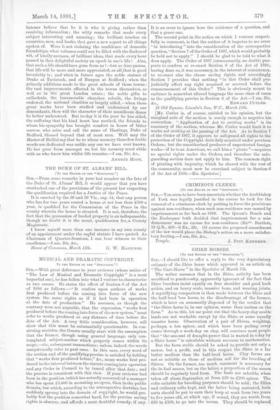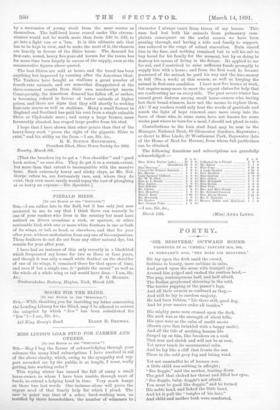SHIRE HORSES.
[To THE EDITOR OF THE " $PECTATOR."] Sin,—I should like to offer a reply to the very depreciatory estimate of the Shire horse which appeared in an article on " The Cart-Horse" in the Spectator of March 7th.
The writer assumes that in the Shire, activity has been sacrificed to ponderosity, apparently ignorant of the fact that Shire breeders insist equally on free shoulder and good hock action, and on heavy scale, massive bone, and wearing joints. A mystifying comparison is then made between the Shire and the half-bred 'bus horse, to the disadvantage of the former, which is later on summarily disposed of by the verdict that "the Shire horse is, in our opinion, worse than useless on the farm." As to this, let me point out that the heavy clay arable lands are not workable except by the Shire or some equally massive horse. Observation of a pair of Shires, weighing, perhaps, a ton apiece, and which have been pulling every ounce through a work-day on clay, will convince most people that" the amount of draught-power that is wasted in a day by a Shire horse " is calculable without recourse to mathematics.
But the farm stable should be asked to provide not only a motor, but a profit, and in this respect the Shire is a far better medium than the half-bred horse. Clay farms are not so suitable as those of medium soil for the breeding of Shires. On the former, too much easement is necessary for the in-foal mares, but on the latter, a proportion of the mares should be regularly bred from. The foals are saleable, when taken off about September, at from £20 to £200 apiece. The colts suitable for breeding purposes should be sold; the fillies and ordinary colts kept, and the latter being castrated, both sorts should be put to earn their keep at work from two years to five years old, at which age, if sound, they are worth from £60 to 2100, to go into the towns. They should be replaced
by a succession of young stock from the same source as themselves. The half-bred horse reared under like circum- stances would not be' worth more than from £40 to 245, to go into a light van or a 'bus. It is this ultimate sale that has to be kept in view, and to make the most of it, the chances are heavily in favour of the Shire horse. The demand for first-rate, sound, heavy five-year-old horses for the towns has for some time been largely in excess of the supply, even at the remunerative figures above quoted.
The best Shires are sold at home, and the breed has been anything but improved by running after the American ideal. The Yankees have bought as stallions a great number of fourth-rate animals, and are somewhat disappointed at the three-cornered results from their own nondescript mares. Consequently, the American demand has fallen off, or rather, is becoming refined in favour of better animals at higher prices, and there are signs that they will shortly be seeking first-rate mares as well as stallions. Many a small farmer in England and Scotland has paid his rent from a single valuable Shire or Clydesdale mare ; and many a large farmer, more favourably situated, has reaped large profits from his stud.
I hope that I have shown that other points than that of the heavy-lorry work " prove the right of the gigantic Shire to exist," and his utility on the farm.—I am, Sir, &c., R. N. SUTTON NELTHORPE, President-Elect, Shire Horse Society for 1892. Scawby, March 9th.
[That the breeders try to get a " free shoulder" and " good hock action," va sans dire. They do get it to a certain extent, but more than that extent is incompatible with the massive bone. Such extremely heavy and sticky clays, as Mr. Nel- thorpe refers to, are fortunately rare, and, where they do exist, they even more rarely would repay the cost of ploughing at so heavy an expense.—En. Spectator.]



































 Previous page
Previous page